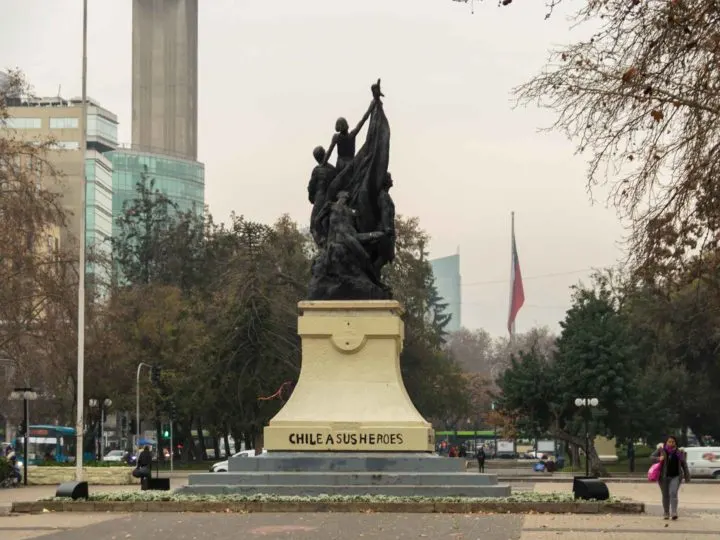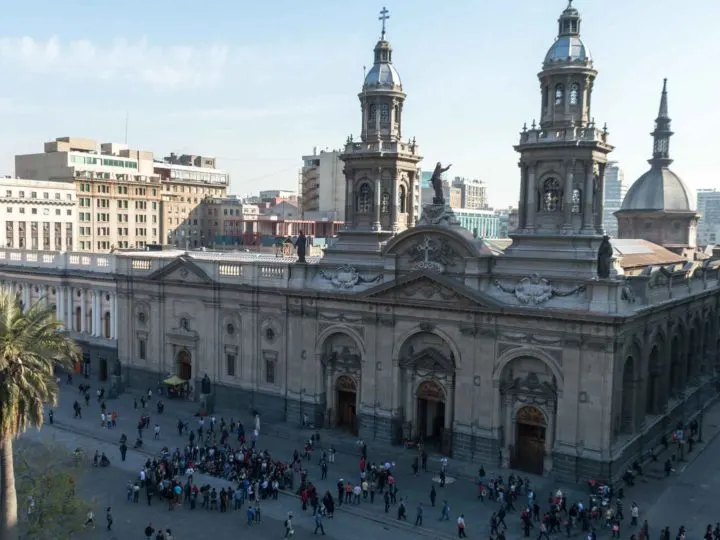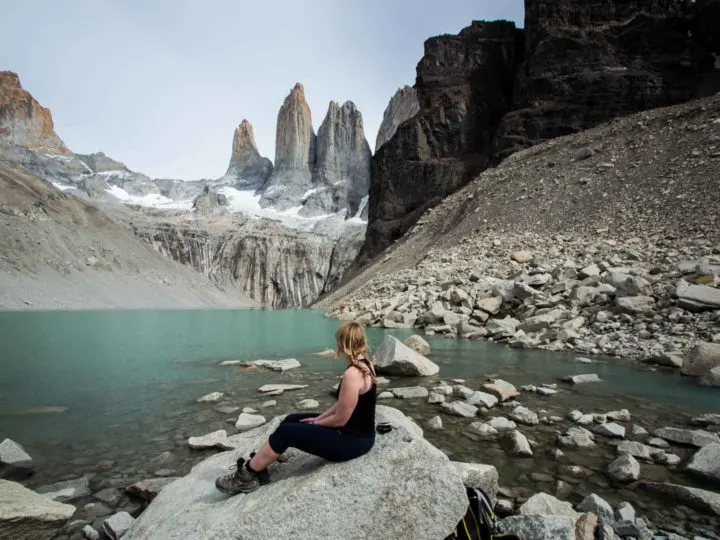Despite Chile’s reputation as one of the safest and most politically stable countries in South America, on Friday the 18th of October 2019, protests erupted in various neighbourhoods across the capital city, Santiago. Following this, they spread to other cities across the country.
What happened between October and December 2019?
The protests began following a 4% hike in fares for Santiago’s metro service, with university students and high-school students calling on passengers to jump over the metro turnstiles to avoid paying the higher fees.
Since then, the protests have developed to encompass a movement to force the right-wing government, led by sitting president Sebastián Piñera, to improve living conditions. The context of the demonstrations is a society where rising living costs and low wages have resulted in high levels of inequality.
During October 2019, these demonstrations escalated to violent protest, with metro stations and other buildings set alight. After President Piñera announced a State of Emergency, the military was deployed and over 20,000 soldiers are now on the streets of the capital and in other parts of the country.
On Friday 25th of October 2019, an estimated 1.2 million people marched through Santiago in protest, a number that represents more than 5% of the country’s population. This was the largest demonstration of its kind since the country returned to democracy following the Pinochet dictatorship of the 70s and 80s.

Water cannons and tear gas have been used to disperse protesters and the current death toll stands at at least 20, with hundreds believed to have partially lost sight due to being shot by rubber bullets. Accusations of the use of extreme force and torture by the military and police are being investigated by the Instituto Nacional de Derechos Humanos (National Institute of Human Rights), while the UN is also sending a team to investigate these claims.
On Monday 28th of October 2019, Piñera fired and replaced eight members of his cabinet in an attempt at quelling the protests. However, many protesters are instead calling for his resignation.
On Friday 19th of November 2019, protesters secured a promise from the government that a plebiscite on writing a new constitution would be held on April 26 2020, with the body responsible for the new constitution being chosen in October of the same year and the document being put to a final vote in 2021.
However, protesters continued to demonstrate their anger towards the government and calls for President Piñera to stand down continue. Small protests in Santiago and across other parts of the country continued for many months.
In early February 2020, protests reignited in the capital, Santiago, with four dead in a series of violent protests. In late February 2020, violent clashes between protestors and police took place outside Hotel O’Higgins, a hotel in which performers for the Viña del Mar Festival (an annual event in the city) were staying.
As of the end of February, protesters geared up for more demonstrations in the capital city, Santiago throughout the month of March. Marches were held throughout the month, with the biggest falling each and ever Monday and Friday of the month of March.
In October 22, 2020, the country voted overwhelmingly to draft a new constitution, with the final referendum on the contents of this new document drafted to be held in the third quarter of 2022.
What’s happening now?
Protests quietened down in during the pandemic, however there is always a risk of nationwide protests taking place, and in Santiago these continue on Friday afternoons and evenings.
Protests also take place in Santiago and other parts of the country every September 11 (anniversary of the military coup), March 29 (‘day of the young combatant’) and May 1 (Workers’ Day). Protests are also held annually in the week leading up to and on October 18 and 19 to mark the anniversary of the first protests being held.
In Santiago, protests tend to be held in and around Plaza Italia (now known as Plaza Dignidad) in the centre of the city and it’s recommended avoiding these areas when any form of protest is occurring as the police can get heavy handed with water canons and tea gas. All of the metro stations are now open, excluding Baquedano (beneath Plaza Italia), which is open from the inside to change trains but you cannot access it from the square above.
How are international visitors affected by the protests in Chile?
Because protests often target the central districts of Santiago, tourist attractions in the Providencia neighbourhood and Downtown Santiago can be closed as a result. It’s always best to consult your hotel or hostel about the current situation of protests before heading out into the city.
In case of a new outbreak of protests, if you speak Spanish, Chilean news agency T13 continues to have rolling coverage and updates on their website, as does BioBio Chile on their Twitter account. The Santiago Municipality’s Twitter account also has information about the status of tourist attractions in the capital, as do Disfruta Santiago.

Travelling outside of Santiago
Bus services are running as usual.
Domestic flights are operating as usual.
Valparaiso
In Valparaiso, protests are still held and can turn violent quickly. Plaza Anibal Pinto (from this square down Esmeralda to Plaza Sotomayor) is where protests tend to take place on occasional Mondays and Fridays from around 5pm, as well as on September 11 (anniversary of the military coup), March 29 (‘day of the young combatant’) and May 1 (Workers’ Day). Protests are also held annually in the week leading up to and on October 18 and 19 to mark the anniversary of the first protests being held.
The tourist destinations (Cerro Alegre and Cerro Bellavista) are operating as normal, but it’s wise to avoid the area around Plaza Anibal Pinto and Plaza Sotomayor.
Because it’s a much smaller city than Santiago, Valparaiso can be chaotic during protests, with transport affected by the demonstrations and a liberal use of tear gas by the authorities.

Governmental recommendations
Both the US State Department and British Foreign Office recommend the exercising increased caution if you travel to Chile:
- Be aware of your surroundings to avoid walking unintentionally into the path of a protest.
- Do not actively seek out demonstrations. You could face arrest, detention or be banned from returning to the country if you are caught taking part in any sort of protest. The Guardian has published footage showing police firing at protesters, so getting involved in a demonstration is extremely dangerous.
- If you find yourself within the vicinity of a demonstration, find a safe place to shelter. This can take the form of a café or restaurant, supermarket or any other nearby building, or try and get away from the location of the protest as quickly as possible.
What does this mean for trips to Chile?
If you have a trip booked to Chile, you will likely only be affected if you are visiting large cities such as Santiago and Valparaiso and protests do break out again. This is unlikely if you avoid Friday afternoons in Plaza Italia, but the situation is volatile and can change at a moment’s notice.
It is recommended you keep an eye on the situation and consult the relevant travel advisories as issued by your government.
- In the US, the State Department has travel advisories in place for COVID-19 but not for protests. They also recommend you enrol in the US Government’s Smart Traveller Enrolment Program to ensure that you get alerts about the current situation
- In the UK, the Foreign Office has also travel advisories in place for COVID-19 but not for protests.
Further reading and information
This article isn’t intended to take a political stance on the situation, however, I am fully in support of any peaceful protesting by local people who deserve to live a dignified life, free of inequality and with full access to health care, education and a decent living wage.
If you are interested in learning more about the political context that predates the current protests, this English-language summary of the climate of governmental corruption and disproportionate use of sentencing for civilians and politicians matched with and a rise in living standards and inequality is an excellent place to start.
The New York Times have also written a balanced article examining how the Chilean neo-liberal economic system is failing its people.
Hashtags on Twitter that are being used by protesters and give a far broader view of what is happening (and what isn’t currently being reported in the media) include #ChileDespierta and #ChileNoEstaEnGuerra.

Terence Lee
Thursday 20th of October 2022
You do not mention that average incomes in Chile are 4 times those in the rest of Latin America
Jen
Tuesday 17th of December 2019
Hey there,
Planning a trip to TDP in late February next year and would like to visit the wine region a few days prior. Given the current situation, we we’re planning to skip Santiago and head straight to Santa Cruz. However, it looks like the only way to travel from the Santiago airport to Santa Cruz is by bus meaning we would need to head to the bus terminal in Santiago. Do you have any info to share on if these terminals are safe or if there tend to be protests here given the proximity to the metro?
Thanks!
Steph Dyson
Friday 3rd of January 2020
Hi Jen, the terminal is safe and there are only minimal protests happening in Santiago now (generally Friday late afternoon/evening in Plaza de Italia). You won't have any issues but keep a firm eye/hand on your belongings as pickpockets are pretty rife in the bus station. Steph
Varanchai Chavaltanpipat
Saturday 30th of November 2019
Hi Steph,
I hope you are well and safe there. We are 5 people from Thailand planning to visit Torres del Paine in early April by flying from Buenos Aires to Punta Arenas. We would like to check some information for our planning as follow: 1. Is it good to rent a car at Punta Arenas airport to drive to TDP? 2. If it's good, do you have any suggestion about car rental company in Punta Arenas airport. As I checked some are not good and will try to avoid. 3. We plan to stay in a hotel in TDP for 3 - 4 days. Is it allowed to drive a car in TDP and stay there ? 4. For TDP entrance ticket, do we need to buy in advance or we can buy at the entrance.
Thanks and best regards,
Varanchai
Steph Dyson
Friday 13th of December 2019
Hi Varanchai, I always recommend that readers use RentalCars as they are generally the cheapest and give you information in English. I also generally use international companies rather than local companies as I have personally found the local companies to unreliable. Yes you can drive to TDP and stay there. And no, you can buy at the entrance. Enjoy your trip! Steph
TOM LocoLoco1
Sunday 24th of November 2019
Steph, Hi. Q: Is it true that a great many shopping arcades and 'Wal-mart' shopping Centres have been ransacked in some larger Chilean cities? How goes it travelling as of late Nov, 2019?
Steph Dyson
Friday 13th of December 2019
Yes a lot of them have been but that shouldn't affect travellers (unless you were planning on coming for the shopping - which I wouldn't recommend in Chile!). Steph
Belinda
Friday 22nd of November 2019
Thanks very much for taking the time to share this info. Much appreciated.
Belinda
Steph Dyson
Friday 22nd of November 2019
Thanks Belinda! Steph